Operation and Project Management: TESCO Case Study
VerifiedAdded on 2023/01/16
|18
|5219
|25
AI Summary
This assignment discusses the implementation of operational management principles in TESCO, along with a continuous improvement plan and the application of project life cycle in a case study.
Contribute Materials
Your contribution can guide someone’s learning journey. Share your
documents today.
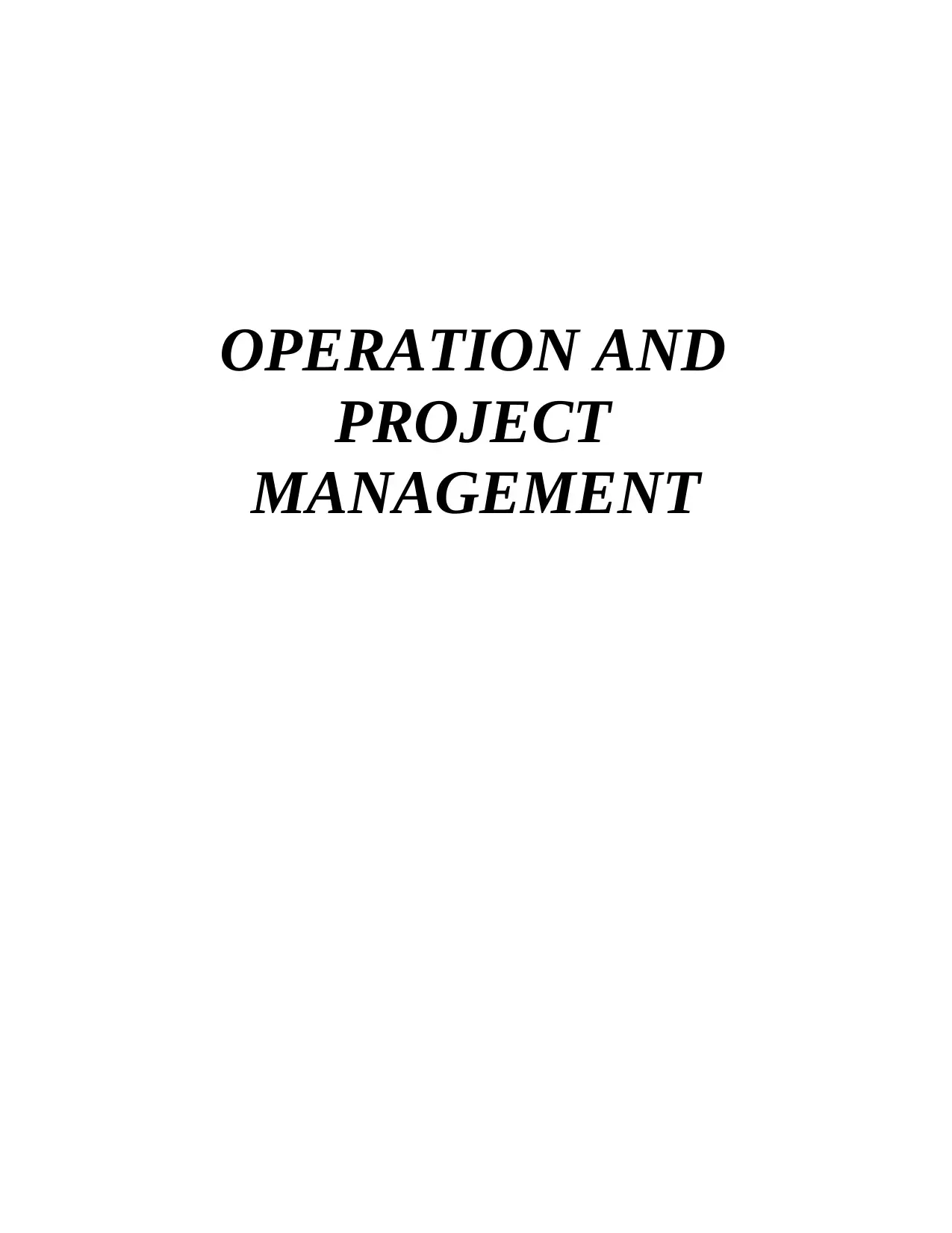
OPERATION AND
PROJECT
MANAGEMENT
PROJECT
MANAGEMENT
Secure Best Marks with AI Grader
Need help grading? Try our AI Grader for instant feedback on your assignments.
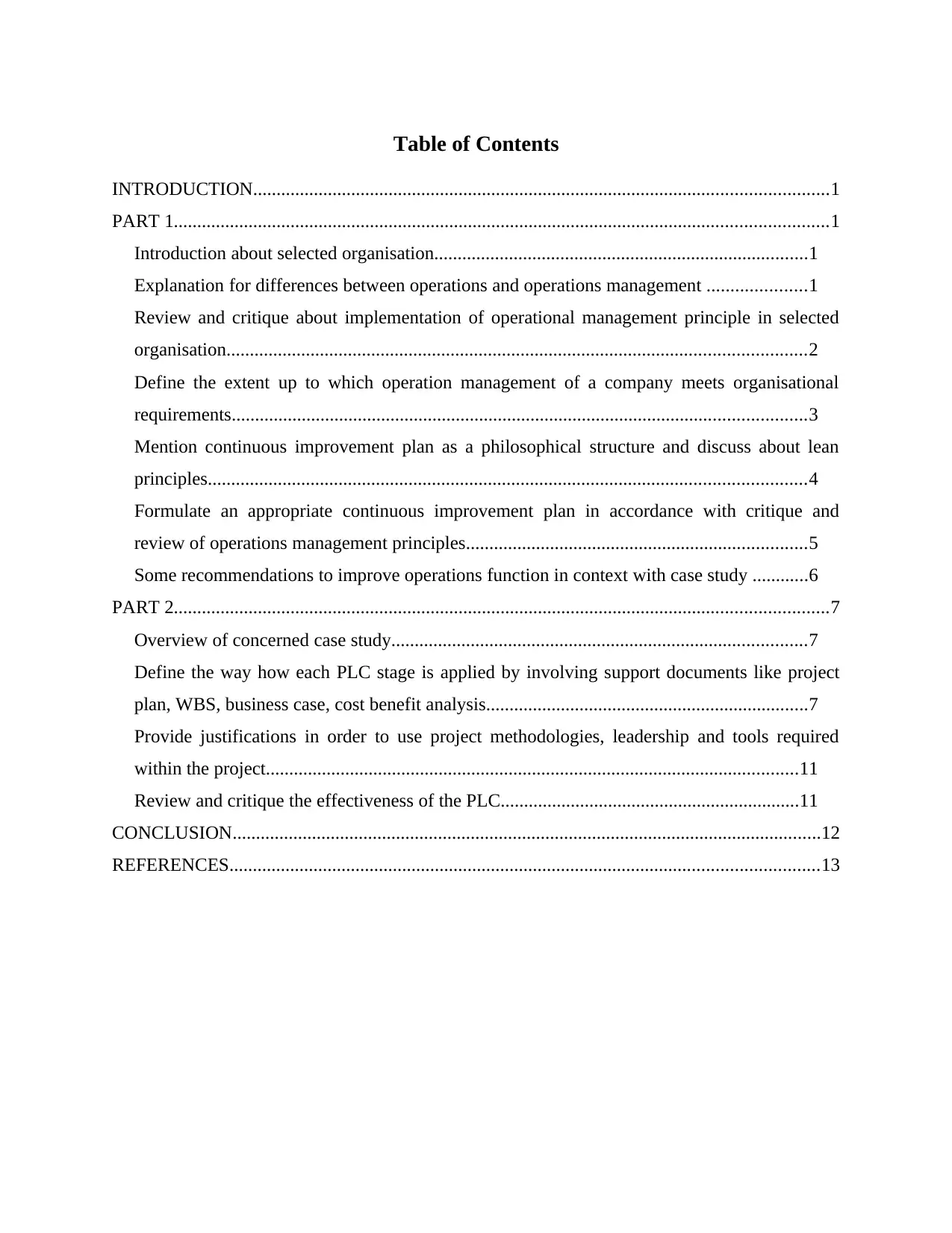
Table of Contents
INTRODUCTION...........................................................................................................................1
PART 1............................................................................................................................................1
Introduction about selected organisation................................................................................1
Explanation for differences between operations and operations management .....................1
Review and critique about implementation of operational management principle in selected
organisation............................................................................................................................2
Define the extent up to which operation management of a company meets organisational
requirements...........................................................................................................................3
Mention continuous improvement plan as a philosophical structure and discuss about lean
principles................................................................................................................................4
Formulate an appropriate continuous improvement plan in accordance with critique and
review of operations management principles.........................................................................5
Some recommendations to improve operations function in context with case study ............6
PART 2............................................................................................................................................7
Overview of concerned case study.........................................................................................7
Define the way how each PLC stage is applied by involving support documents like project
plan, WBS, business case, cost benefit analysis.....................................................................7
Provide justifications in order to use project methodologies, leadership and tools required
within the project..................................................................................................................11
Review and critique the effectiveness of the PLC................................................................11
CONCLUSION..............................................................................................................................12
REFERENCES..............................................................................................................................13
INTRODUCTION...........................................................................................................................1
PART 1............................................................................................................................................1
Introduction about selected organisation................................................................................1
Explanation for differences between operations and operations management .....................1
Review and critique about implementation of operational management principle in selected
organisation............................................................................................................................2
Define the extent up to which operation management of a company meets organisational
requirements...........................................................................................................................3
Mention continuous improvement plan as a philosophical structure and discuss about lean
principles................................................................................................................................4
Formulate an appropriate continuous improvement plan in accordance with critique and
review of operations management principles.........................................................................5
Some recommendations to improve operations function in context with case study ............6
PART 2............................................................................................................................................7
Overview of concerned case study.........................................................................................7
Define the way how each PLC stage is applied by involving support documents like project
plan, WBS, business case, cost benefit analysis.....................................................................7
Provide justifications in order to use project methodologies, leadership and tools required
within the project..................................................................................................................11
Review and critique the effectiveness of the PLC................................................................11
CONCLUSION..............................................................................................................................12
REFERENCES..............................................................................................................................13
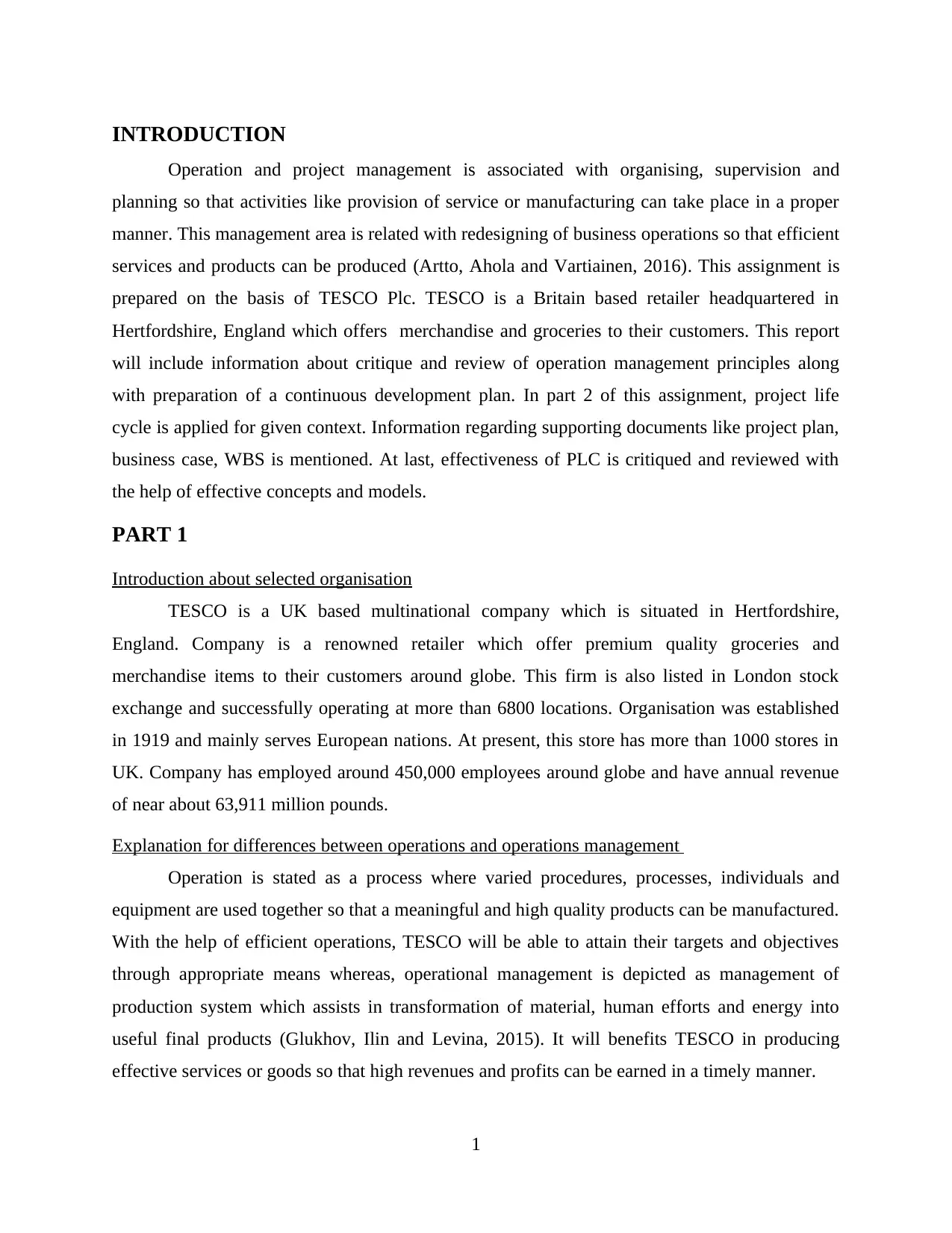
INTRODUCTION
Operation and project management is associated with organising, supervision and
planning so that activities like provision of service or manufacturing can take place in a proper
manner. This management area is related with redesigning of business operations so that efficient
services and products can be produced (Artto, Ahola and Vartiainen, 2016). This assignment is
prepared on the basis of TESCO Plc. TESCO is a Britain based retailer headquartered in
Hertfordshire, England which offers merchandise and groceries to their customers. This report
will include information about critique and review of operation management principles along
with preparation of a continuous development plan. In part 2 of this assignment, project life
cycle is applied for given context. Information regarding supporting documents like project plan,
business case, WBS is mentioned. At last, effectiveness of PLC is critiqued and reviewed with
the help of effective concepts and models.
PART 1
Introduction about selected organisation
TESCO is a UK based multinational company which is situated in Hertfordshire,
England. Company is a renowned retailer which offer premium quality groceries and
merchandise items to their customers around globe. This firm is also listed in London stock
exchange and successfully operating at more than 6800 locations. Organisation was established
in 1919 and mainly serves European nations. At present, this store has more than 1000 stores in
UK. Company has employed around 450,000 employees around globe and have annual revenue
of near about 63,911 million pounds.
Explanation for differences between operations and operations management
Operation is stated as a process where varied procedures, processes, individuals and
equipment are used together so that a meaningful and high quality products can be manufactured.
With the help of efficient operations, TESCO will be able to attain their targets and objectives
through appropriate means whereas, operational management is depicted as management of
production system which assists in transformation of material, human efforts and energy into
useful final products (Glukhov, Ilin and Levina, 2015). It will benefits TESCO in producing
effective services or goods so that high revenues and profits can be earned in a timely manner.
1
Operation and project management is associated with organising, supervision and
planning so that activities like provision of service or manufacturing can take place in a proper
manner. This management area is related with redesigning of business operations so that efficient
services and products can be produced (Artto, Ahola and Vartiainen, 2016). This assignment is
prepared on the basis of TESCO Plc. TESCO is a Britain based retailer headquartered in
Hertfordshire, England which offers merchandise and groceries to their customers. This report
will include information about critique and review of operation management principles along
with preparation of a continuous development plan. In part 2 of this assignment, project life
cycle is applied for given context. Information regarding supporting documents like project plan,
business case, WBS is mentioned. At last, effectiveness of PLC is critiqued and reviewed with
the help of effective concepts and models.
PART 1
Introduction about selected organisation
TESCO is a UK based multinational company which is situated in Hertfordshire,
England. Company is a renowned retailer which offer premium quality groceries and
merchandise items to their customers around globe. This firm is also listed in London stock
exchange and successfully operating at more than 6800 locations. Organisation was established
in 1919 and mainly serves European nations. At present, this store has more than 1000 stores in
UK. Company has employed around 450,000 employees around globe and have annual revenue
of near about 63,911 million pounds.
Explanation for differences between operations and operations management
Operation is stated as a process where varied procedures, processes, individuals and
equipment are used together so that a meaningful and high quality products can be manufactured.
With the help of efficient operations, TESCO will be able to attain their targets and objectives
through appropriate means whereas, operational management is depicted as management of
production system which assists in transformation of material, human efforts and energy into
useful final products (Glukhov, Ilin and Levina, 2015). It will benefits TESCO in producing
effective services or goods so that high revenues and profits can be earned in a timely manner.
1
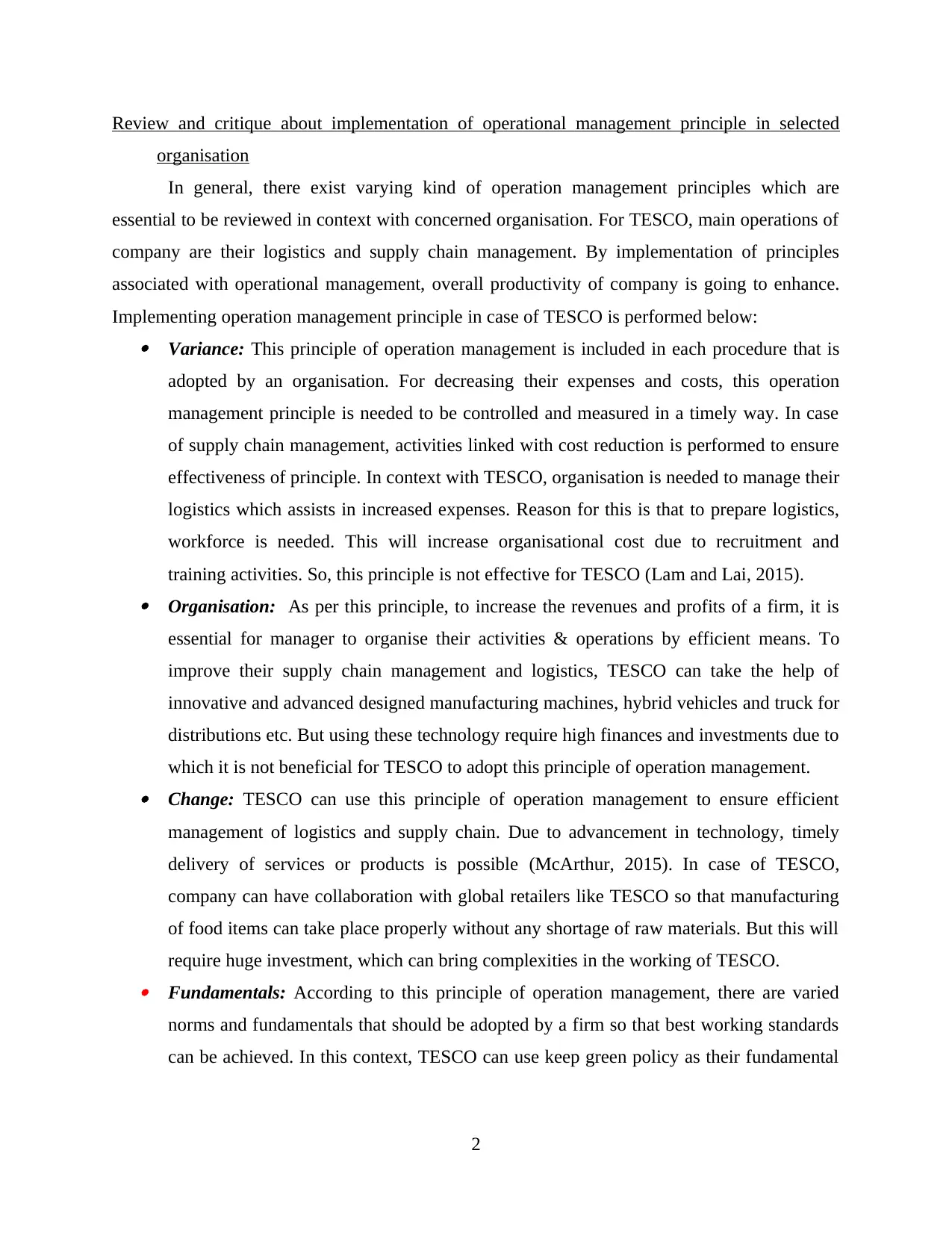
Review and critique about implementation of operational management principle in selected
organisation
In general, there exist varying kind of operation management principles which are
essential to be reviewed in context with concerned organisation. For TESCO, main operations of
company are their logistics and supply chain management. By implementation of principles
associated with operational management, overall productivity of company is going to enhance.
Implementing operation management principle in case of TESCO is performed below: Variance: This principle of operation management is included in each procedure that is
adopted by an organisation. For decreasing their expenses and costs, this operation
management principle is needed to be controlled and measured in a timely way. In case
of supply chain management, activities linked with cost reduction is performed to ensure
effectiveness of principle. In context with TESCO, organisation is needed to manage their
logistics which assists in increased expenses. Reason for this is that to prepare logistics,
workforce is needed. This will increase organisational cost due to recruitment and
training activities. So, this principle is not effective for TESCO (Lam and Lai, 2015). Organisation: As per this principle, to increase the revenues and profits of a firm, it is
essential for manager to organise their activities & operations by efficient means. To
improve their supply chain management and logistics, TESCO can take the help of
innovative and advanced designed manufacturing machines, hybrid vehicles and truck for
distributions etc. But using these technology require high finances and investments due to
which it is not beneficial for TESCO to adopt this principle of operation management. Change: TESCO can use this principle of operation management to ensure efficient
management of logistics and supply chain. Due to advancement in technology, timely
delivery of services or products is possible (McArthur, 2015). In case of TESCO,
company can have collaboration with global retailers like TESCO so that manufacturing
of food items can take place properly without any shortage of raw materials. But this will
require huge investment, which can bring complexities in the working of TESCO. Fundamentals: According to this principle of operation management, there are varied
norms and fundamentals that should be adopted by a firm so that best working standards
can be achieved. In this context, TESCO can use keep green policy as their fundamental
2
organisation
In general, there exist varying kind of operation management principles which are
essential to be reviewed in context with concerned organisation. For TESCO, main operations of
company are their logistics and supply chain management. By implementation of principles
associated with operational management, overall productivity of company is going to enhance.
Implementing operation management principle in case of TESCO is performed below: Variance: This principle of operation management is included in each procedure that is
adopted by an organisation. For decreasing their expenses and costs, this operation
management principle is needed to be controlled and measured in a timely way. In case
of supply chain management, activities linked with cost reduction is performed to ensure
effectiveness of principle. In context with TESCO, organisation is needed to manage their
logistics which assists in increased expenses. Reason for this is that to prepare logistics,
workforce is needed. This will increase organisational cost due to recruitment and
training activities. So, this principle is not effective for TESCO (Lam and Lai, 2015). Organisation: As per this principle, to increase the revenues and profits of a firm, it is
essential for manager to organise their activities & operations by efficient means. To
improve their supply chain management and logistics, TESCO can take the help of
innovative and advanced designed manufacturing machines, hybrid vehicles and truck for
distributions etc. But using these technology require high finances and investments due to
which it is not beneficial for TESCO to adopt this principle of operation management. Change: TESCO can use this principle of operation management to ensure efficient
management of logistics and supply chain. Due to advancement in technology, timely
delivery of services or products is possible (McArthur, 2015). In case of TESCO,
company can have collaboration with global retailers like TESCO so that manufacturing
of food items can take place properly without any shortage of raw materials. But this will
require huge investment, which can bring complexities in the working of TESCO. Fundamentals: According to this principle of operation management, there are varied
norms and fundamentals that should be adopted by a firm so that best working standards
can be achieved. In this context, TESCO can use keep green policy as their fundamental
2
Paraphrase This Document
Need a fresh take? Get an instant paraphrase of this document with our AI Paraphraser

clause that ensures enhanced sustainability. Implementation of this principle will be very
useful for TESCO.
Six Sigma: It refers to a method with the help of which manager of the company reduces
all the wastage up to a limited extent. It has been said that six sigma assist an organisation in
order to gain loyalty from customer. It is the tool which is used by organisation which mainly
follows DMAIC approach which mainly says define, improve, analyse, measure as well as
control the functions so that high quality goods and services will be produced. It has also been
said that Six sigma is a tool used to resolve problems and issues which is associated with the
operations. In the present context of TESCO, managers of the company adopt this method in
order to minimise the defects and issues so that they can satisfy the requirements and needs of
customers. With the help of above stated it has been said that by using six sigma method within
the workplace in an effective manner than it will able to produce positive
Define the extent up to which operation management of a company meets organisational
requirements
It is essential for TESCO to analyse each operation management principle before
implementing it. If these management principles are not capable to fulfil needs and requirements,
then it is not beneficial for an organisation to adopt them. In this context, analysis to
acknowledge if these principles meet requirements of TESCO is mentioned below:
Most important aspect for TESCO is to reduce their expenses incurred on business
operations and activities. Under this, manager of TESCO uses variance principle so that
their product line can be increased which will reduce overall cost of company. This
variance principle is capable to decrease operational costs and did not assist in enhancing
product line of a firm by reducing overall cost. Hence, this principle do not meet the
needs of TESCO (Rosemann and vom Brocke, 2015).
Another necessity for TESCO is to have consistent operations. In context with logistics
and management of supply chain, some activities results in inconsistency for organisation
due to their complexities. For example, installation of modern machinery needs expertise
due to which recruiting expenses will be high. Hence, it can be said that every business
activity face some kind of barrier due to which organisation principle is not able to meet
organisational demands.
3
useful for TESCO.
Six Sigma: It refers to a method with the help of which manager of the company reduces
all the wastage up to a limited extent. It has been said that six sigma assist an organisation in
order to gain loyalty from customer. It is the tool which is used by organisation which mainly
follows DMAIC approach which mainly says define, improve, analyse, measure as well as
control the functions so that high quality goods and services will be produced. It has also been
said that Six sigma is a tool used to resolve problems and issues which is associated with the
operations. In the present context of TESCO, managers of the company adopt this method in
order to minimise the defects and issues so that they can satisfy the requirements and needs of
customers. With the help of above stated it has been said that by using six sigma method within
the workplace in an effective manner than it will able to produce positive
Define the extent up to which operation management of a company meets organisational
requirements
It is essential for TESCO to analyse each operation management principle before
implementing it. If these management principles are not capable to fulfil needs and requirements,
then it is not beneficial for an organisation to adopt them. In this context, analysis to
acknowledge if these principles meet requirements of TESCO is mentioned below:
Most important aspect for TESCO is to reduce their expenses incurred on business
operations and activities. Under this, manager of TESCO uses variance principle so that
their product line can be increased which will reduce overall cost of company. This
variance principle is capable to decrease operational costs and did not assist in enhancing
product line of a firm by reducing overall cost. Hence, this principle do not meet the
needs of TESCO (Rosemann and vom Brocke, 2015).
Another necessity for TESCO is to have consistent operations. In context with logistics
and management of supply chain, some activities results in inconsistency for organisation
due to their complexities. For example, installation of modern machinery needs expertise
due to which recruiting expenses will be high. Hence, it can be said that every business
activity face some kind of barrier due to which organisation principle is not able to meet
organisational demands.
3
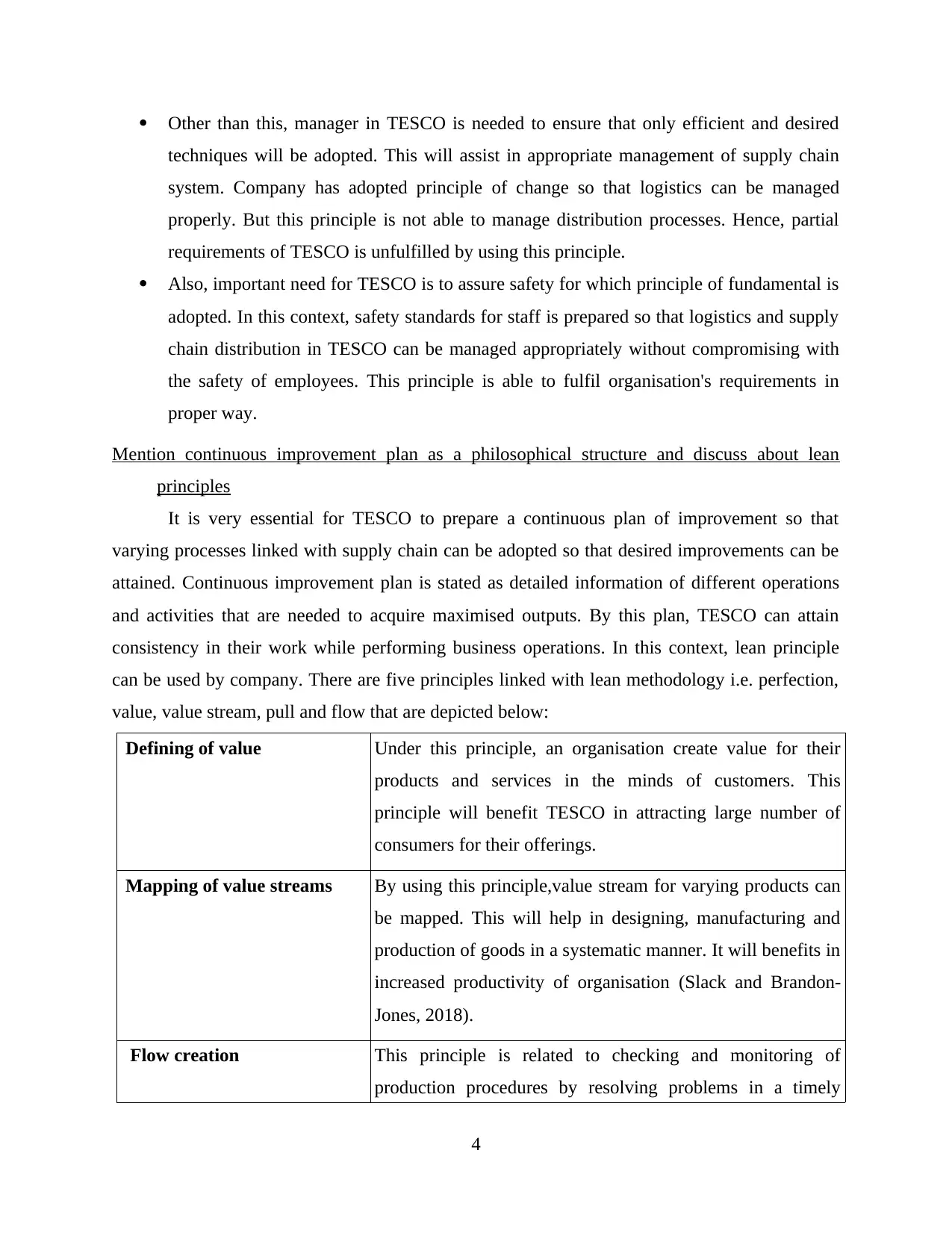
Other than this, manager in TESCO is needed to ensure that only efficient and desired
techniques will be adopted. This will assist in appropriate management of supply chain
system. Company has adopted principle of change so that logistics can be managed
properly. But this principle is not able to manage distribution processes. Hence, partial
requirements of TESCO is unfulfilled by using this principle.
Also, important need for TESCO is to assure safety for which principle of fundamental is
adopted. In this context, safety standards for staff is prepared so that logistics and supply
chain distribution in TESCO can be managed appropriately without compromising with
the safety of employees. This principle is able to fulfil organisation's requirements in
proper way.
Mention continuous improvement plan as a philosophical structure and discuss about lean
principles
It is very essential for TESCO to prepare a continuous plan of improvement so that
varying processes linked with supply chain can be adopted so that desired improvements can be
attained. Continuous improvement plan is stated as detailed information of different operations
and activities that are needed to acquire maximised outputs. By this plan, TESCO can attain
consistency in their work while performing business operations. In this context, lean principle
can be used by company. There are five principles linked with lean methodology i.e. perfection,
value, value stream, pull and flow that are depicted below:
Defining of value Under this principle, an organisation create value for their
products and services in the minds of customers. This
principle will benefit TESCO in attracting large number of
consumers for their offerings.
Mapping of value streams By using this principle,value stream for varying products can
be mapped. This will help in designing, manufacturing and
production of goods in a systematic manner. It will benefits in
increased productivity of organisation (Slack and Brandon-
Jones, 2018).
Flow creation This principle is related to checking and monitoring of
production procedures by resolving problems in a timely
4
techniques will be adopted. This will assist in appropriate management of supply chain
system. Company has adopted principle of change so that logistics can be managed
properly. But this principle is not able to manage distribution processes. Hence, partial
requirements of TESCO is unfulfilled by using this principle.
Also, important need for TESCO is to assure safety for which principle of fundamental is
adopted. In this context, safety standards for staff is prepared so that logistics and supply
chain distribution in TESCO can be managed appropriately without compromising with
the safety of employees. This principle is able to fulfil organisation's requirements in
proper way.
Mention continuous improvement plan as a philosophical structure and discuss about lean
principles
It is very essential for TESCO to prepare a continuous plan of improvement so that
varying processes linked with supply chain can be adopted so that desired improvements can be
attained. Continuous improvement plan is stated as detailed information of different operations
and activities that are needed to acquire maximised outputs. By this plan, TESCO can attain
consistency in their work while performing business operations. In this context, lean principle
can be used by company. There are five principles linked with lean methodology i.e. perfection,
value, value stream, pull and flow that are depicted below:
Defining of value Under this principle, an organisation create value for their
products and services in the minds of customers. This
principle will benefit TESCO in attracting large number of
consumers for their offerings.
Mapping of value streams By using this principle,value stream for varying products can
be mapped. This will help in designing, manufacturing and
production of goods in a systematic manner. It will benefits in
increased productivity of organisation (Slack and Brandon-
Jones, 2018).
Flow creation This principle is related to checking and monitoring of
production procedures by resolving problems in a timely
4
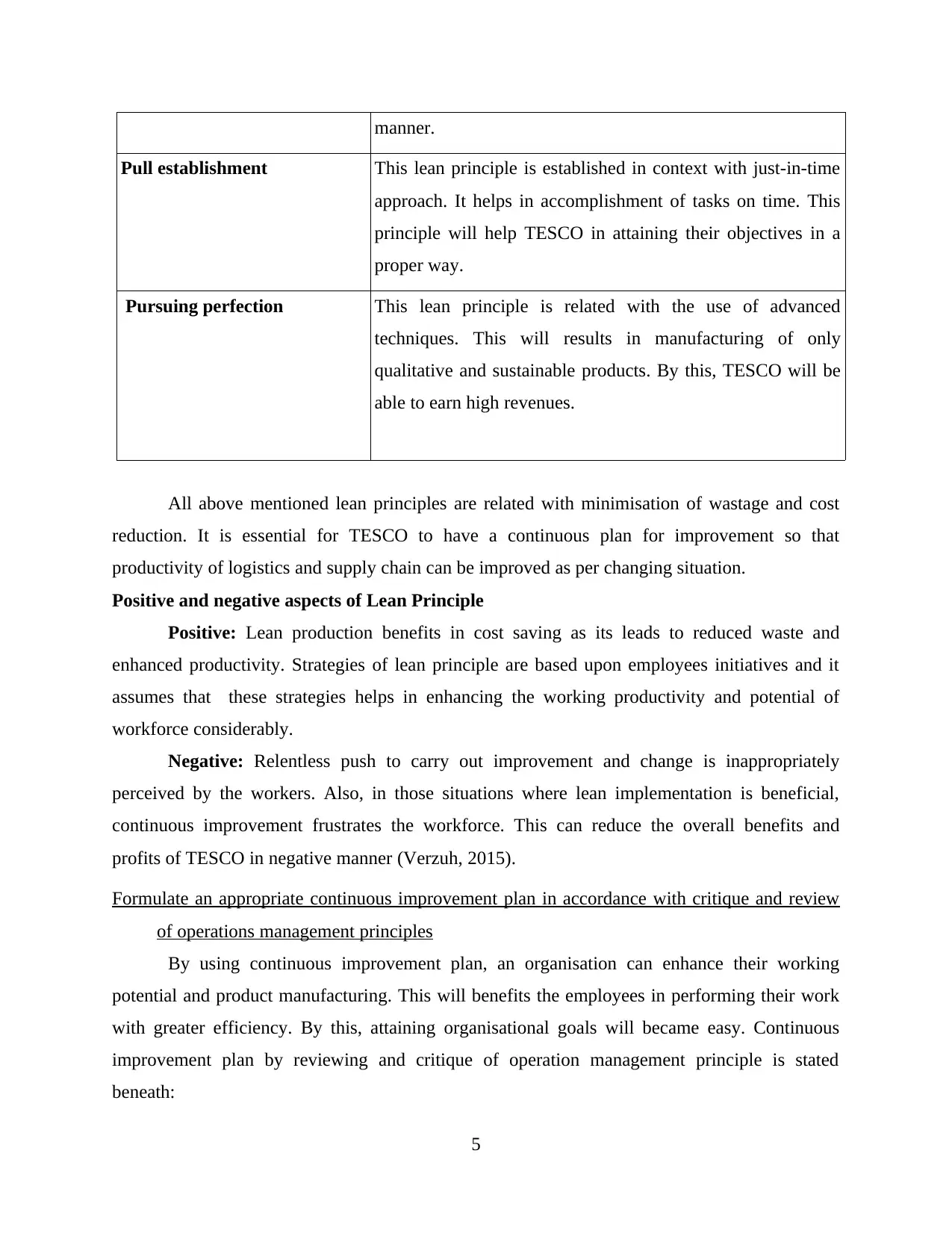
manner.
Pull establishment This lean principle is established in context with just-in-time
approach. It helps in accomplishment of tasks on time. This
principle will help TESCO in attaining their objectives in a
proper way.
Pursuing perfection This lean principle is related with the use of advanced
techniques. This will results in manufacturing of only
qualitative and sustainable products. By this, TESCO will be
able to earn high revenues.
All above mentioned lean principles are related with minimisation of wastage and cost
reduction. It is essential for TESCO to have a continuous plan for improvement so that
productivity of logistics and supply chain can be improved as per changing situation.
Positive and negative aspects of Lean Principle
Positive: Lean production benefits in cost saving as its leads to reduced waste and
enhanced productivity. Strategies of lean principle are based upon employees initiatives and it
assumes that these strategies helps in enhancing the working productivity and potential of
workforce considerably.
Negative: Relentless push to carry out improvement and change is inappropriately
perceived by the workers. Also, in those situations where lean implementation is beneficial,
continuous improvement frustrates the workforce. This can reduce the overall benefits and
profits of TESCO in negative manner (Verzuh, 2015).
Formulate an appropriate continuous improvement plan in accordance with critique and review
of operations management principles
By using continuous improvement plan, an organisation can enhance their working
potential and product manufacturing. This will benefits the employees in performing their work
with greater efficiency. By this, attaining organisational goals will became easy. Continuous
improvement plan by reviewing and critique of operation management principle is stated
beneath:
5
Pull establishment This lean principle is established in context with just-in-time
approach. It helps in accomplishment of tasks on time. This
principle will help TESCO in attaining their objectives in a
proper way.
Pursuing perfection This lean principle is related with the use of advanced
techniques. This will results in manufacturing of only
qualitative and sustainable products. By this, TESCO will be
able to earn high revenues.
All above mentioned lean principles are related with minimisation of wastage and cost
reduction. It is essential for TESCO to have a continuous plan for improvement so that
productivity of logistics and supply chain can be improved as per changing situation.
Positive and negative aspects of Lean Principle
Positive: Lean production benefits in cost saving as its leads to reduced waste and
enhanced productivity. Strategies of lean principle are based upon employees initiatives and it
assumes that these strategies helps in enhancing the working productivity and potential of
workforce considerably.
Negative: Relentless push to carry out improvement and change is inappropriately
perceived by the workers. Also, in those situations where lean implementation is beneficial,
continuous improvement frustrates the workforce. This can reduce the overall benefits and
profits of TESCO in negative manner (Verzuh, 2015).
Formulate an appropriate continuous improvement plan in accordance with critique and review
of operations management principles
By using continuous improvement plan, an organisation can enhance their working
potential and product manufacturing. This will benefits the employees in performing their work
with greater efficiency. By this, attaining organisational goals will became easy. Continuous
improvement plan by reviewing and critique of operation management principle is stated
beneath:
5
Secure Best Marks with AI Grader
Need help grading? Try our AI Grader for instant feedback on your assignments.
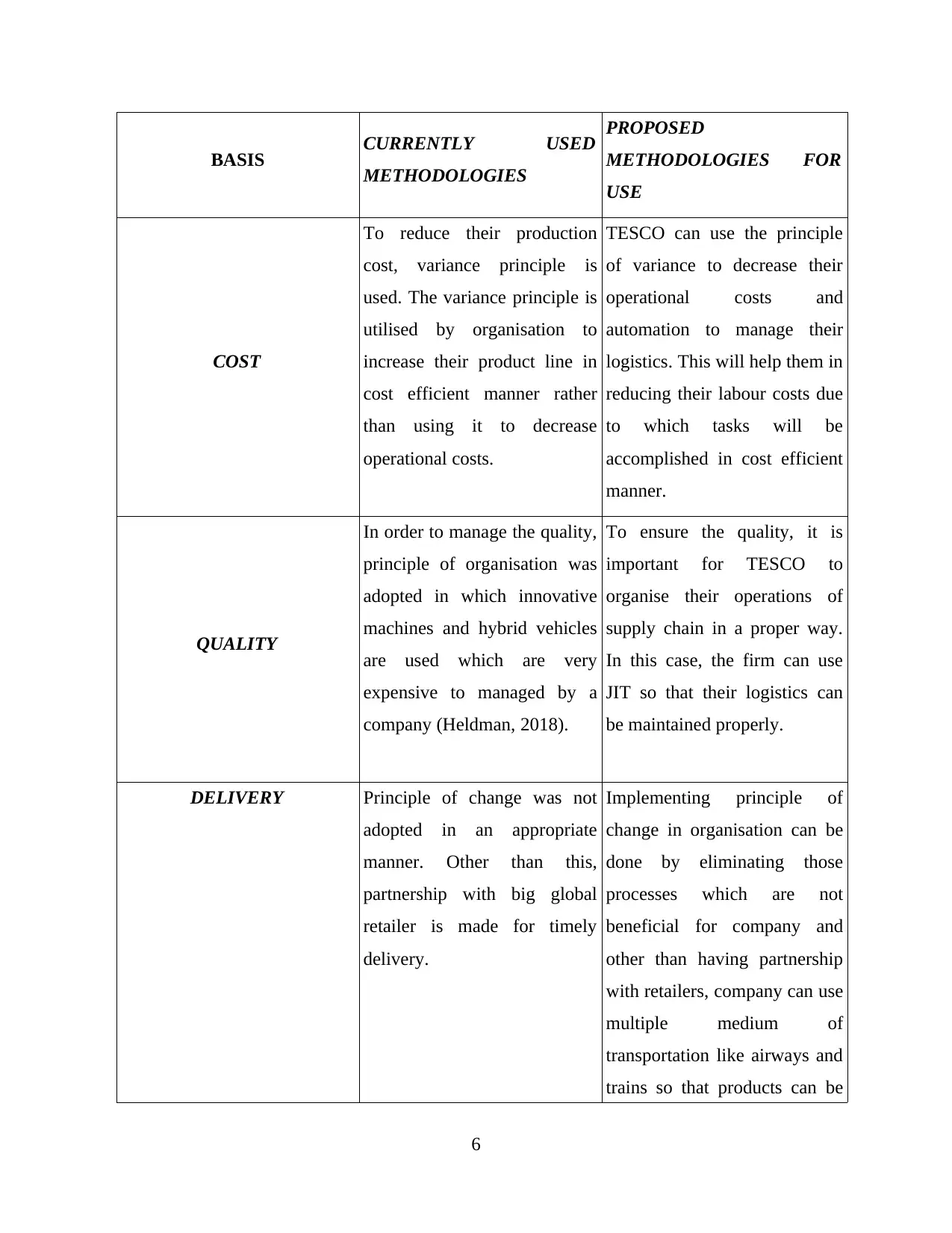
BASIS CURRENTLY USED
METHODOLOGIES
PROPOSED
METHODOLOGIES FOR
USE
COST
To reduce their production
cost, variance principle is
used. The variance principle is
utilised by organisation to
increase their product line in
cost efficient manner rather
than using it to decrease
operational costs.
TESCO can use the principle
of variance to decrease their
operational costs and
automation to manage their
logistics. This will help them in
reducing their labour costs due
to which tasks will be
accomplished in cost efficient
manner.
QUALITY
In order to manage the quality,
principle of organisation was
adopted in which innovative
machines and hybrid vehicles
are used which are very
expensive to managed by a
company (Heldman, 2018).
To ensure the quality, it is
important for TESCO to
organise their operations of
supply chain in a proper way.
In this case, the firm can use
JIT so that their logistics can
be maintained properly.
DELIVERY Principle of change was not
adopted in an appropriate
manner. Other than this,
partnership with big global
retailer is made for timely
delivery.
Implementing principle of
change in organisation can be
done by eliminating those
processes which are not
beneficial for company and
other than having partnership
with retailers, company can use
multiple medium of
transportation like airways and
trains so that products can be
6
METHODOLOGIES
PROPOSED
METHODOLOGIES FOR
USE
COST
To reduce their production
cost, variance principle is
used. The variance principle is
utilised by organisation to
increase their product line in
cost efficient manner rather
than using it to decrease
operational costs.
TESCO can use the principle
of variance to decrease their
operational costs and
automation to manage their
logistics. This will help them in
reducing their labour costs due
to which tasks will be
accomplished in cost efficient
manner.
QUALITY
In order to manage the quality,
principle of organisation was
adopted in which innovative
machines and hybrid vehicles
are used which are very
expensive to managed by a
company (Heldman, 2018).
To ensure the quality, it is
important for TESCO to
organise their operations of
supply chain in a proper way.
In this case, the firm can use
JIT so that their logistics can
be maintained properly.
DELIVERY Principle of change was not
adopted in an appropriate
manner. Other than this,
partnership with big global
retailer is made for timely
delivery.
Implementing principle of
change in organisation can be
done by eliminating those
processes which are not
beneficial for company and
other than having partnership
with retailers, company can use
multiple medium of
transportation like airways and
trains so that products can be
6

distributed in timely manner.
Some recommendations to improve operations function in context with case study
As per the principle of operational management and aspects of continuous improvement
plan, some recommendations can be given to manager in TESCO. These recommendations are
stated below:
Concerned company can use artificial intelligence and automation so improve the quality
of their products. By these aspects, manual works of the company will be reduced. This
will benefits the employees in TESCO in fulfilling the expectations of customers in a
proper manner by giving them more time and solving their query efficiently.
Manager in TESCO is recommended to use Just-In-Time inventory which will ensure
that only those resources and materials will be used which are in high demand by
customers. Due to this, purchasing of extra materials will be reduced and optimal use of
purchased products will be achieved. Other than this, it will benefits the organisation in
reducing their expenses which are spend on storing stokes in stores and warehouses. By
this, overall cost of the firm will reduce and high revenues can be achieved.
PART 2
Overview of concerned case study
High Speed 2 is a planned high speed railway within UK. It has been analyzed that
Parliament approved the plans in the year 2017, with the clearance that work need to be
undertaken for the stations and line. After successfully completing the first phase, there are
various different phases need to be launched which covers almost 21 destinations of Britain
(Perry and et. al., 2018). For accomplishing all the goals and objectives in a positive manner,
there are different types of strategies which need to be followed by the managers which includes
various tools as well as techniques.
Define the way how each PLC stage is applied by involving support documents like project plan,
WBS, business case, cost benefit analysis
It has been identified that a business case is a written document which includes value
proposition with the intention of educating a decision maker and convince them in order to take
some positive actions. This is considered as one of the most effective method where detail
7
Some recommendations to improve operations function in context with case study
As per the principle of operational management and aspects of continuous improvement
plan, some recommendations can be given to manager in TESCO. These recommendations are
stated below:
Concerned company can use artificial intelligence and automation so improve the quality
of their products. By these aspects, manual works of the company will be reduced. This
will benefits the employees in TESCO in fulfilling the expectations of customers in a
proper manner by giving them more time and solving their query efficiently.
Manager in TESCO is recommended to use Just-In-Time inventory which will ensure
that only those resources and materials will be used which are in high demand by
customers. Due to this, purchasing of extra materials will be reduced and optimal use of
purchased products will be achieved. Other than this, it will benefits the organisation in
reducing their expenses which are spend on storing stokes in stores and warehouses. By
this, overall cost of the firm will reduce and high revenues can be achieved.
PART 2
Overview of concerned case study
High Speed 2 is a planned high speed railway within UK. It has been analyzed that
Parliament approved the plans in the year 2017, with the clearance that work need to be
undertaken for the stations and line. After successfully completing the first phase, there are
various different phases need to be launched which covers almost 21 destinations of Britain
(Perry and et. al., 2018). For accomplishing all the goals and objectives in a positive manner,
there are different types of strategies which need to be followed by the managers which includes
various tools as well as techniques.
Define the way how each PLC stage is applied by involving support documents like project plan,
WBS, business case, cost benefit analysis
It has been identified that a business case is a written document which includes value
proposition with the intention of educating a decision maker and convince them in order to take
some positive actions. This is considered as one of the most effective method where detail
7
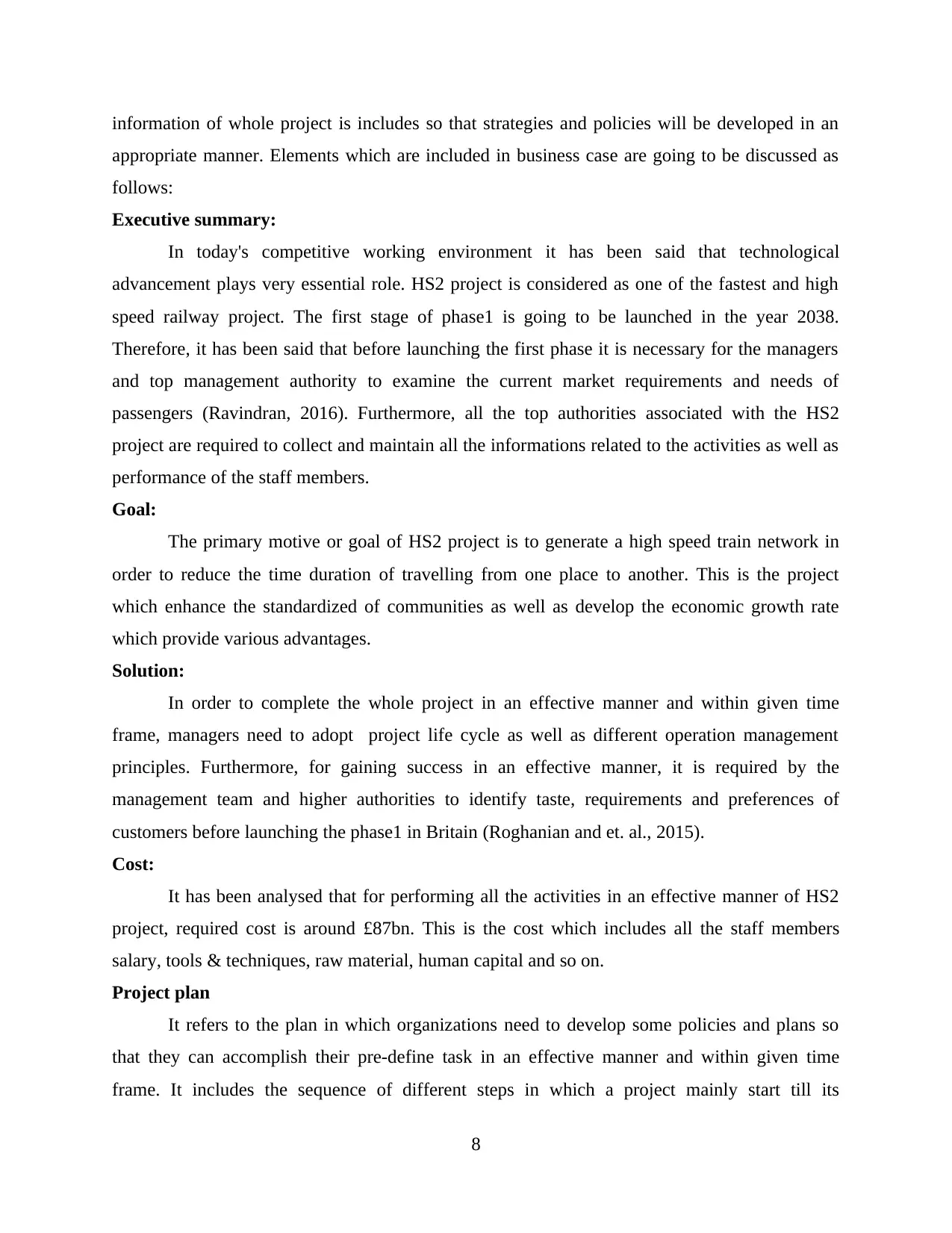
information of whole project is includes so that strategies and policies will be developed in an
appropriate manner. Elements which are included in business case are going to be discussed as
follows:
Executive summary:
In today's competitive working environment it has been said that technological
advancement plays very essential role. HS2 project is considered as one of the fastest and high
speed railway project. The first stage of phase1 is going to be launched in the year 2038.
Therefore, it has been said that before launching the first phase it is necessary for the managers
and top management authority to examine the current market requirements and needs of
passengers (Ravindran, 2016). Furthermore, all the top authorities associated with the HS2
project are required to collect and maintain all the informations related to the activities as well as
performance of the staff members.
Goal:
The primary motive or goal of HS2 project is to generate a high speed train network in
order to reduce the time duration of travelling from one place to another. This is the project
which enhance the standardized of communities as well as develop the economic growth rate
which provide various advantages.
Solution:
In order to complete the whole project in an effective manner and within given time
frame, managers need to adopt project life cycle as well as different operation management
principles. Furthermore, for gaining success in an effective manner, it is required by the
management team and higher authorities to identify taste, requirements and preferences of
customers before launching the phase1 in Britain (Roghanian and et. al., 2015).
Cost:
It has been analysed that for performing all the activities in an effective manner of HS2
project, required cost is around £87bn. This is the cost which includes all the staff members
salary, tools & techniques, raw material, human capital and so on.
Project plan
It refers to the plan in which organizations need to develop some policies and plans so
that they can accomplish their pre-define task in an effective manner and within given time
frame. It includes the sequence of different steps in which a project mainly start till its
8
appropriate manner. Elements which are included in business case are going to be discussed as
follows:
Executive summary:
In today's competitive working environment it has been said that technological
advancement plays very essential role. HS2 project is considered as one of the fastest and high
speed railway project. The first stage of phase1 is going to be launched in the year 2038.
Therefore, it has been said that before launching the first phase it is necessary for the managers
and top management authority to examine the current market requirements and needs of
passengers (Ravindran, 2016). Furthermore, all the top authorities associated with the HS2
project are required to collect and maintain all the informations related to the activities as well as
performance of the staff members.
Goal:
The primary motive or goal of HS2 project is to generate a high speed train network in
order to reduce the time duration of travelling from one place to another. This is the project
which enhance the standardized of communities as well as develop the economic growth rate
which provide various advantages.
Solution:
In order to complete the whole project in an effective manner and within given time
frame, managers need to adopt project life cycle as well as different operation management
principles. Furthermore, for gaining success in an effective manner, it is required by the
management team and higher authorities to identify taste, requirements and preferences of
customers before launching the phase1 in Britain (Roghanian and et. al., 2015).
Cost:
It has been analysed that for performing all the activities in an effective manner of HS2
project, required cost is around £87bn. This is the cost which includes all the staff members
salary, tools & techniques, raw material, human capital and so on.
Project plan
It refers to the plan in which organizations need to develop some policies and plans so
that they can accomplish their pre-define task in an effective manner and within given time
frame. It includes the sequence of different steps in which a project mainly start till its
8
Paraphrase This Document
Need a fresh take? Get an instant paraphrase of this document with our AI Paraphraser
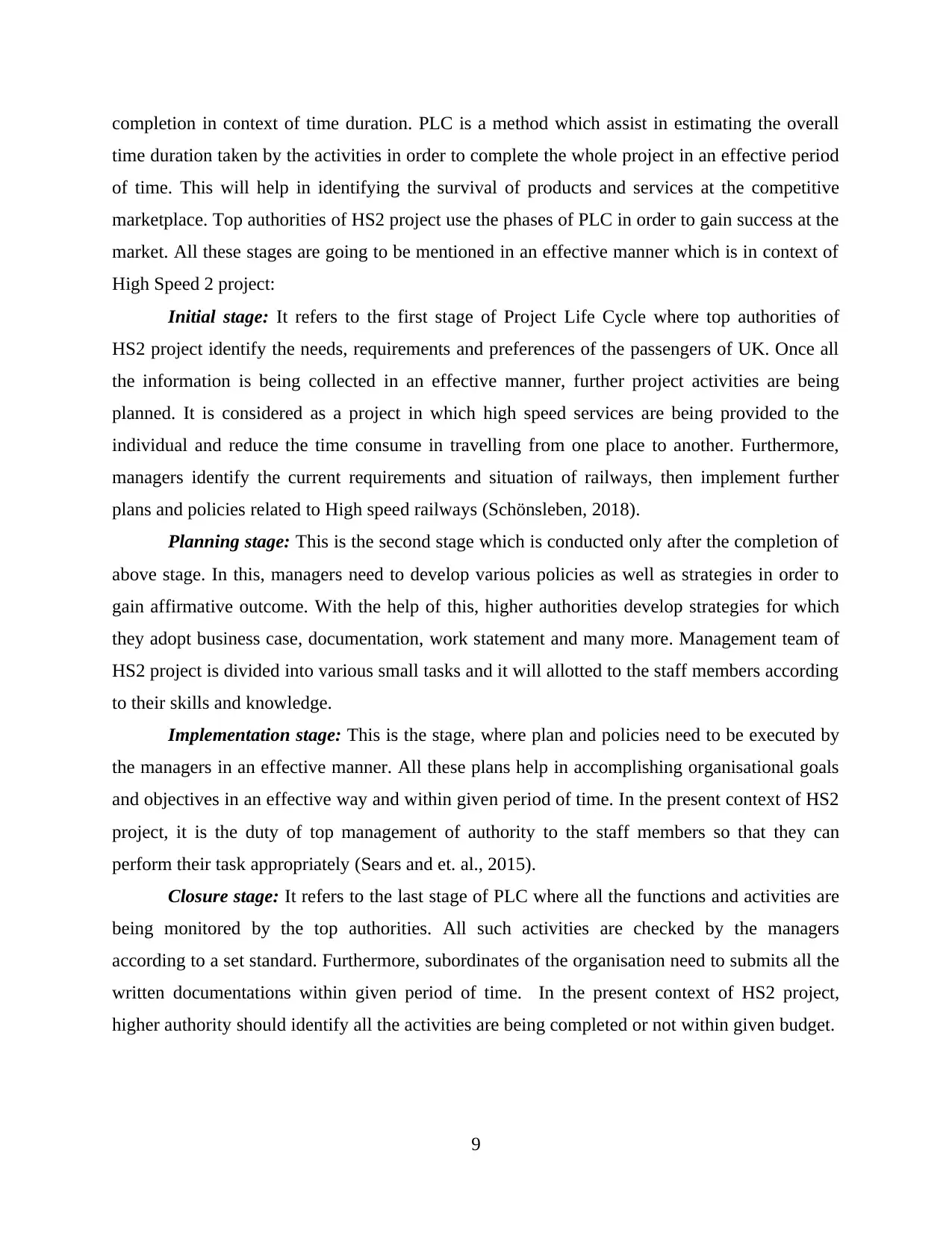
completion in context of time duration. PLC is a method which assist in estimating the overall
time duration taken by the activities in order to complete the whole project in an effective period
of time. This will help in identifying the survival of products and services at the competitive
marketplace. Top authorities of HS2 project use the phases of PLC in order to gain success at the
market. All these stages are going to be mentioned in an effective manner which is in context of
High Speed 2 project:
Initial stage: It refers to the first stage of Project Life Cycle where top authorities of
HS2 project identify the needs, requirements and preferences of the passengers of UK. Once all
the information is being collected in an effective manner, further project activities are being
planned. It is considered as a project in which high speed services are being provided to the
individual and reduce the time consume in travelling from one place to another. Furthermore,
managers identify the current requirements and situation of railways, then implement further
plans and policies related to High speed railways (Schönsleben, 2018).
Planning stage: This is the second stage which is conducted only after the completion of
above stage. In this, managers need to develop various policies as well as strategies in order to
gain affirmative outcome. With the help of this, higher authorities develop strategies for which
they adopt business case, documentation, work statement and many more. Management team of
HS2 project is divided into various small tasks and it will allotted to the staff members according
to their skills and knowledge.
Implementation stage: This is the stage, where plan and policies need to be executed by
the managers in an effective manner. All these plans help in accomplishing organisational goals
and objectives in an effective way and within given period of time. In the present context of HS2
project, it is the duty of top management of authority to the staff members so that they can
perform their task appropriately (Sears and et. al., 2015).
Closure stage: It refers to the last stage of PLC where all the functions and activities are
being monitored by the top authorities. All such activities are checked by the managers
according to a set standard. Furthermore, subordinates of the organisation need to submits all the
written documentations within given period of time. In the present context of HS2 project,
higher authority should identify all the activities are being completed or not within given budget.
9
time duration taken by the activities in order to complete the whole project in an effective period
of time. This will help in identifying the survival of products and services at the competitive
marketplace. Top authorities of HS2 project use the phases of PLC in order to gain success at the
market. All these stages are going to be mentioned in an effective manner which is in context of
High Speed 2 project:
Initial stage: It refers to the first stage of Project Life Cycle where top authorities of
HS2 project identify the needs, requirements and preferences of the passengers of UK. Once all
the information is being collected in an effective manner, further project activities are being
planned. It is considered as a project in which high speed services are being provided to the
individual and reduce the time consume in travelling from one place to another. Furthermore,
managers identify the current requirements and situation of railways, then implement further
plans and policies related to High speed railways (Schönsleben, 2018).
Planning stage: This is the second stage which is conducted only after the completion of
above stage. In this, managers need to develop various policies as well as strategies in order to
gain affirmative outcome. With the help of this, higher authorities develop strategies for which
they adopt business case, documentation, work statement and many more. Management team of
HS2 project is divided into various small tasks and it will allotted to the staff members according
to their skills and knowledge.
Implementation stage: This is the stage, where plan and policies need to be executed by
the managers in an effective manner. All these plans help in accomplishing organisational goals
and objectives in an effective way and within given period of time. In the present context of HS2
project, it is the duty of top management of authority to the staff members so that they can
perform their task appropriately (Sears and et. al., 2015).
Closure stage: It refers to the last stage of PLC where all the functions and activities are
being monitored by the top authorities. All such activities are checked by the managers
according to a set standard. Furthermore, subordinates of the organisation need to submits all the
written documentations within given period of time. In the present context of HS2 project,
higher authority should identify all the activities are being completed or not within given budget.
9
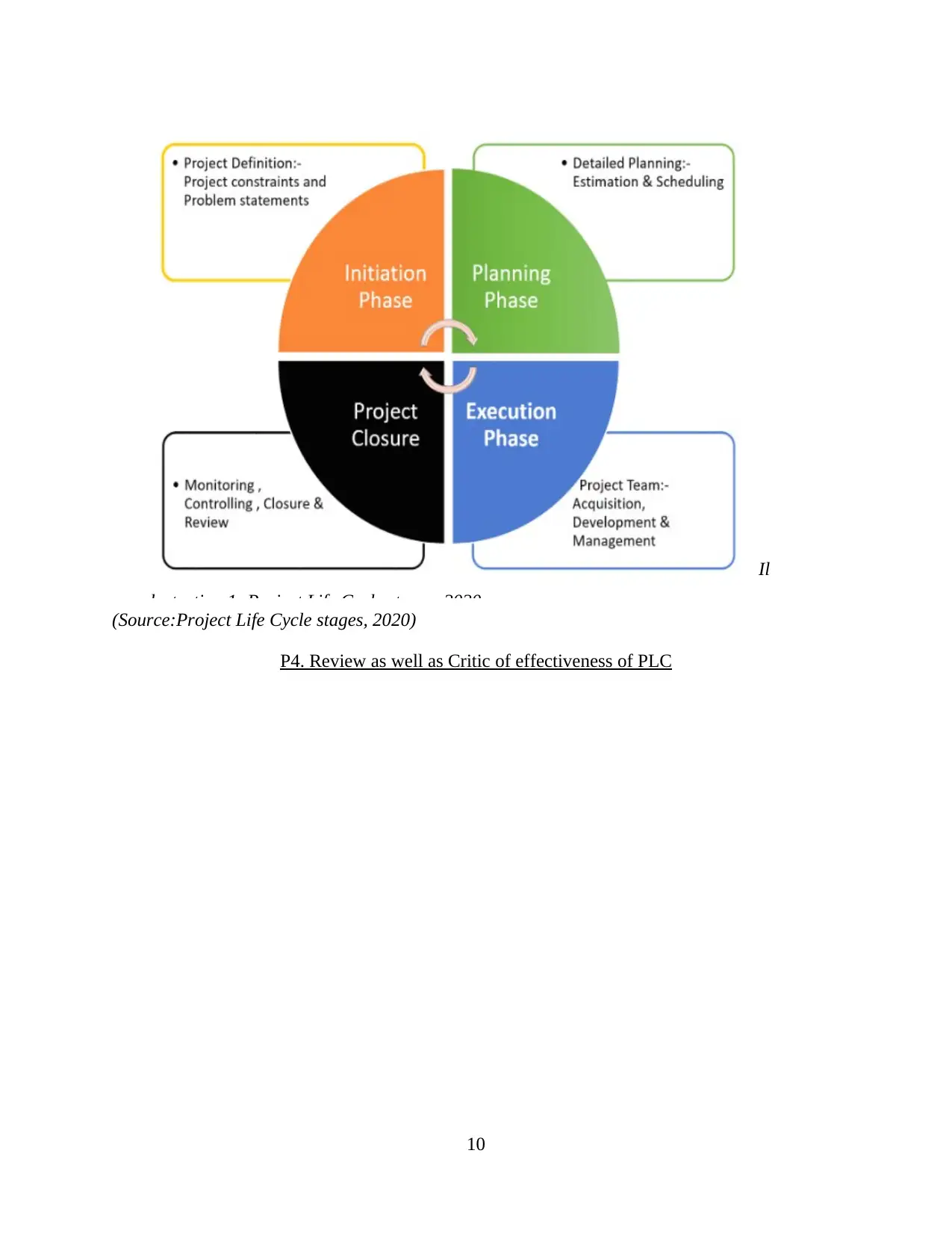
(Source:Project Life Cycle stages, 2020)
P4. Review as well as Critic of effectiveness of PLC
10
Il
lustration 1: Project Life Cycle stages, 2020
P4. Review as well as Critic of effectiveness of PLC
10
Il
lustration 1: Project Life Cycle stages, 2020
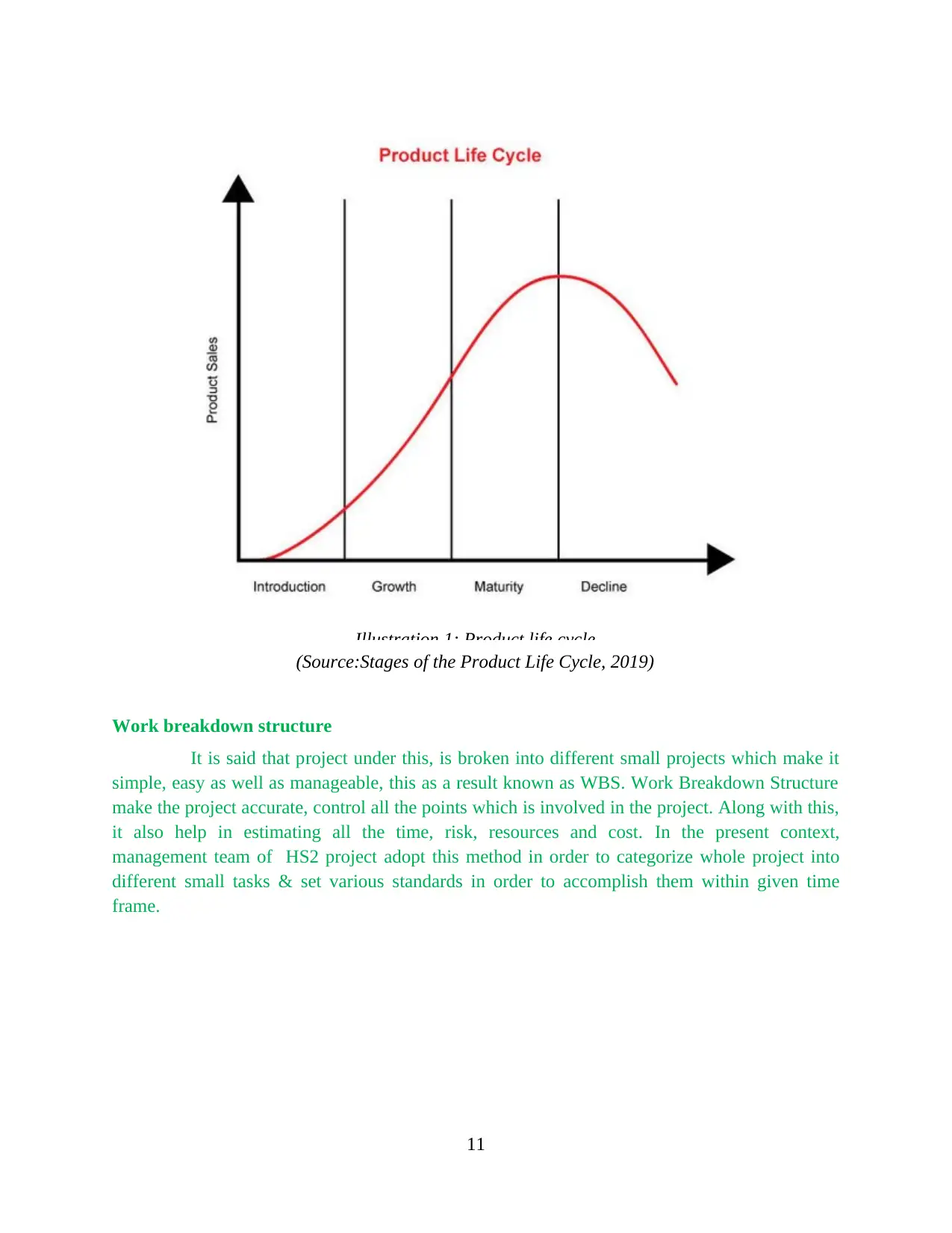
(Source:Stages of the Product Life Cycle, 2019)
Work breakdown structure
It is said that project under this, is broken into different small projects which make it
simple, easy as well as manageable, this as a result known as WBS. Work Breakdown Structure
make the project accurate, control all the points which is involved in the project. Along with this,
it also help in estimating all the time, risk, resources and cost. In the present context,
management team of HS2 project adopt this method in order to categorize whole project into
different small tasks & set various standards in order to accomplish them within given time
frame.
11
Illustration 1: Product life cycle
Work breakdown structure
It is said that project under this, is broken into different small projects which make it
simple, easy as well as manageable, this as a result known as WBS. Work Breakdown Structure
make the project accurate, control all the points which is involved in the project. Along with this,
it also help in estimating all the time, risk, resources and cost. In the present context,
management team of HS2 project adopt this method in order to categorize whole project into
different small tasks & set various standards in order to accomplish them within given time
frame.
11
Illustration 1: Product life cycle
Secure Best Marks with AI Grader
Need help grading? Try our AI Grader for instant feedback on your assignments.
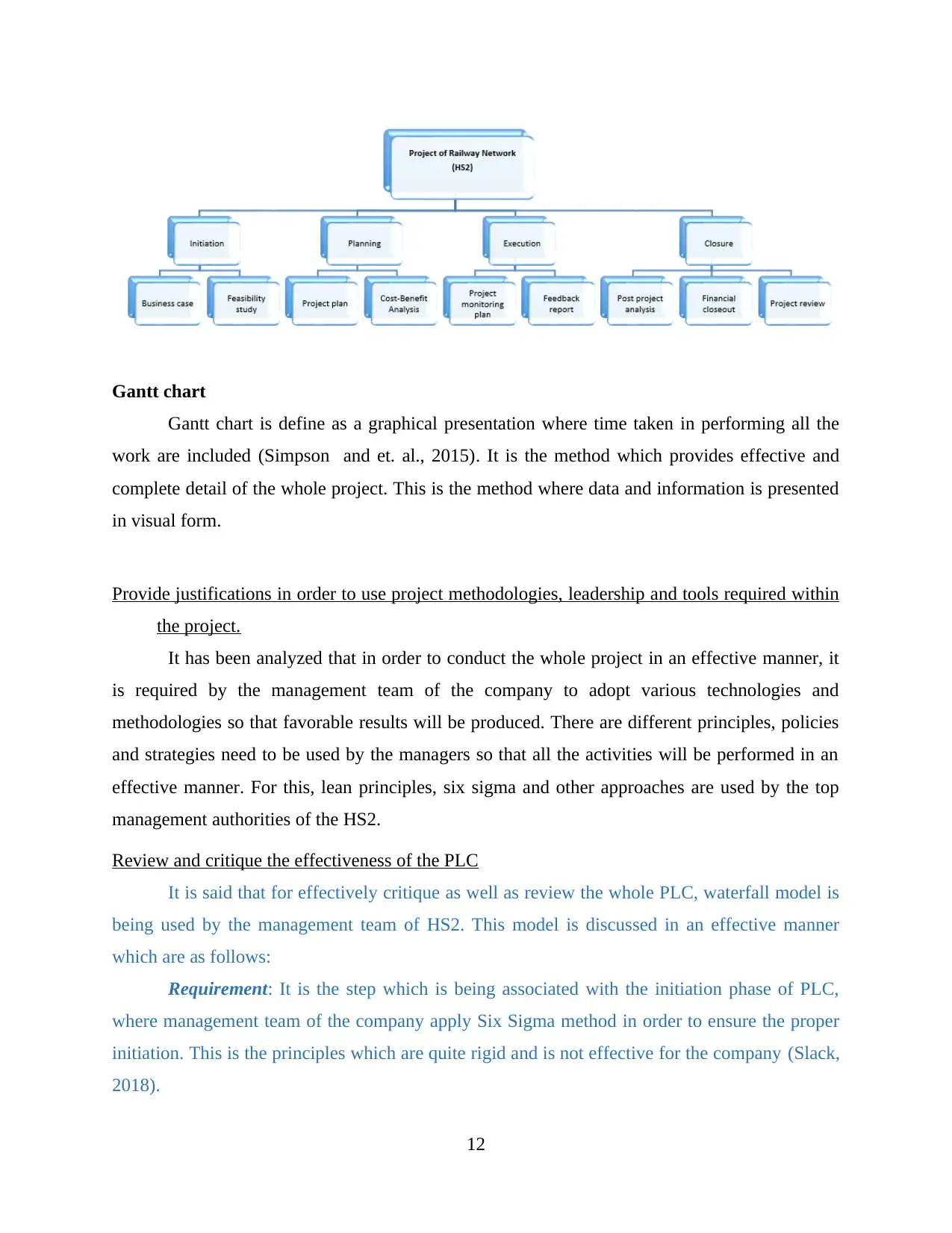
Gantt chart
Gantt chart is define as a graphical presentation where time taken in performing all the
work are included (Simpson and et. al., 2015). It is the method which provides effective and
complete detail of the whole project. This is the method where data and information is presented
in visual form.
Provide justifications in order to use project methodologies, leadership and tools required within
the project.
It has been analyzed that in order to conduct the whole project in an effective manner, it
is required by the management team of the company to adopt various technologies and
methodologies so that favorable results will be produced. There are different principles, policies
and strategies need to be used by the managers so that all the activities will be performed in an
effective manner. For this, lean principles, six sigma and other approaches are used by the top
management authorities of the HS2.
Review and critique the effectiveness of the PLC
It is said that for effectively critique as well as review the whole PLC, waterfall model is
being used by the management team of HS2. This model is discussed in an effective manner
which are as follows:
Requirement: It is the step which is being associated with the initiation phase of PLC,
where management team of the company apply Six Sigma method in order to ensure the proper
initiation. This is the principles which are quite rigid and is not effective for the company (Slack,
2018).
12
Gantt chart is define as a graphical presentation where time taken in performing all the
work are included (Simpson and et. al., 2015). It is the method which provides effective and
complete detail of the whole project. This is the method where data and information is presented
in visual form.
Provide justifications in order to use project methodologies, leadership and tools required within
the project.
It has been analyzed that in order to conduct the whole project in an effective manner, it
is required by the management team of the company to adopt various technologies and
methodologies so that favorable results will be produced. There are different principles, policies
and strategies need to be used by the managers so that all the activities will be performed in an
effective manner. For this, lean principles, six sigma and other approaches are used by the top
management authorities of the HS2.
Review and critique the effectiveness of the PLC
It is said that for effectively critique as well as review the whole PLC, waterfall model is
being used by the management team of HS2. This model is discussed in an effective manner
which are as follows:
Requirement: It is the step which is being associated with the initiation phase of PLC,
where management team of the company apply Six Sigma method in order to ensure the proper
initiation. This is the principles which are quite rigid and is not effective for the company (Slack,
2018).
12
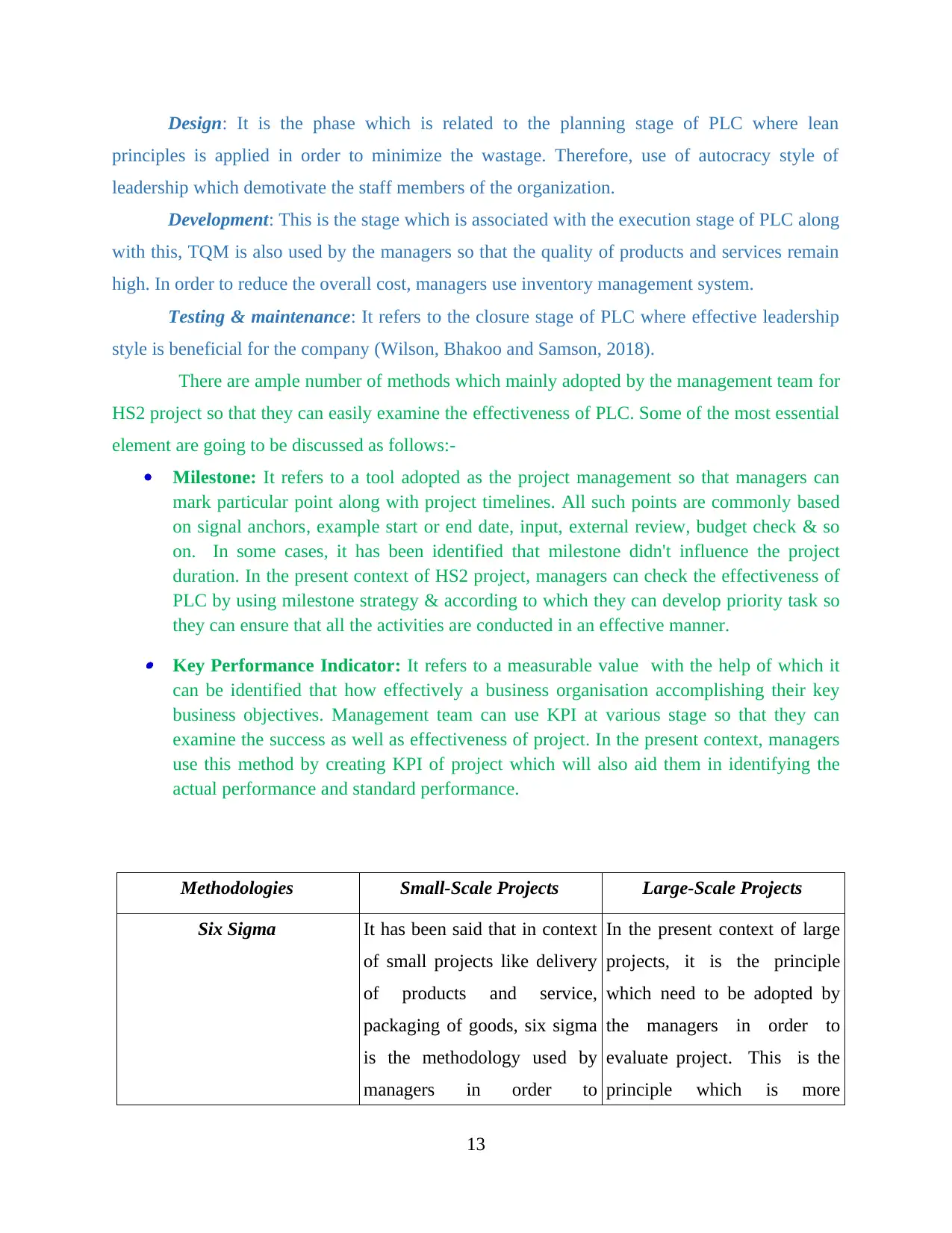
Design: It is the phase which is related to the planning stage of PLC where lean
principles is applied in order to minimize the wastage. Therefore, use of autocracy style of
leadership which demotivate the staff members of the organization.
Development: This is the stage which is associated with the execution stage of PLC along
with this, TQM is also used by the managers so that the quality of products and services remain
high. In order to reduce the overall cost, managers use inventory management system.
Testing & maintenance: It refers to the closure stage of PLC where effective leadership
style is beneficial for the company (Wilson, Bhakoo and Samson, 2018).
There are ample number of methods which mainly adopted by the management team for
HS2 project so that they can easily examine the effectiveness of PLC. Some of the most essential
element are going to be discussed as follows:-
Milestone: It refers to a tool adopted as the project management so that managers can
mark particular point along with project timelines. All such points are commonly based
on signal anchors, example start or end date, input, external review, budget check & so
on. In some cases, it has been identified that milestone didn't influence the project
duration. In the present context of HS2 project, managers can check the effectiveness of
PLC by using milestone strategy & according to which they can develop priority task so
they can ensure that all the activities are conducted in an effective manner. Key Performance Indicator: It refers to a measurable value with the help of which it
can be identified that how effectively a business organisation accomplishing their key
business objectives. Management team can use KPI at various stage so that they can
examine the success as well as effectiveness of project. In the present context, managers
use this method by creating KPI of project which will also aid them in identifying the
actual performance and standard performance.
Methodologies Small-Scale Projects Large-Scale Projects
Six Sigma It has been said that in context
of small projects like delivery
of products and service,
packaging of goods, six sigma
is the methodology used by
managers in order to
In the present context of large
projects, it is the principle
which need to be adopted by
the managers in order to
evaluate project. This is the
principle which is more
13
principles is applied in order to minimize the wastage. Therefore, use of autocracy style of
leadership which demotivate the staff members of the organization.
Development: This is the stage which is associated with the execution stage of PLC along
with this, TQM is also used by the managers so that the quality of products and services remain
high. In order to reduce the overall cost, managers use inventory management system.
Testing & maintenance: It refers to the closure stage of PLC where effective leadership
style is beneficial for the company (Wilson, Bhakoo and Samson, 2018).
There are ample number of methods which mainly adopted by the management team for
HS2 project so that they can easily examine the effectiveness of PLC. Some of the most essential
element are going to be discussed as follows:-
Milestone: It refers to a tool adopted as the project management so that managers can
mark particular point along with project timelines. All such points are commonly based
on signal anchors, example start or end date, input, external review, budget check & so
on. In some cases, it has been identified that milestone didn't influence the project
duration. In the present context of HS2 project, managers can check the effectiveness of
PLC by using milestone strategy & according to which they can develop priority task so
they can ensure that all the activities are conducted in an effective manner. Key Performance Indicator: It refers to a measurable value with the help of which it
can be identified that how effectively a business organisation accomplishing their key
business objectives. Management team can use KPI at various stage so that they can
examine the success as well as effectiveness of project. In the present context, managers
use this method by creating KPI of project which will also aid them in identifying the
actual performance and standard performance.
Methodologies Small-Scale Projects Large-Scale Projects
Six Sigma It has been said that in context
of small projects like delivery
of products and service,
packaging of goods, six sigma
is the methodology used by
managers in order to
In the present context of large
projects, it is the principle
which need to be adopted by
the managers in order to
evaluate project. This is the
principle which is more
13

accomplish the whole project. suitable for the large projects.
Lean Principles It is said that using lean
methodology in order to
complete the small projects
avoid any kind of duplication.
This as a result provide
benefits in order to reducing
cost and efforts of labour.
In context of large projects
such as development of
product or expansions of
business, such principle help in
reducing extra cost.
With the assistance of above discussion, it has been identified that PLC aid a business
organisation in order to plan activities as well as implement them in an effective manner which
helps in accomplishing organizational goals and objectives within given time period. This cycle
focuses on every activities from initial to final stage. This will assist them in producing high
quality products and services. Apart from this, it will enhance the overall productivity which
produces positive influence on profit as well as revenue of the business organisation.
CONCLUSION
With the help of above mentioned report, it has been concluded that operation as well as
project management is one of the most effective procedure with the help of which positive
outcome will be produced. In this report, an effective PLC is developed with the help of which
managers will be able to identify that whether the product can survive at the competitive
marketplace or not. Along with this, it is the said that there is a continuous improvement plan as
well as six sigma plan which give guidance and support to the managers in order to bring
modifications and for satisfy the needs and requirements of customers.
14
Lean Principles It is said that using lean
methodology in order to
complete the small projects
avoid any kind of duplication.
This as a result provide
benefits in order to reducing
cost and efforts of labour.
In context of large projects
such as development of
product or expansions of
business, such principle help in
reducing extra cost.
With the assistance of above discussion, it has been identified that PLC aid a business
organisation in order to plan activities as well as implement them in an effective manner which
helps in accomplishing organizational goals and objectives within given time period. This cycle
focuses on every activities from initial to final stage. This will assist them in producing high
quality products and services. Apart from this, it will enhance the overall productivity which
produces positive influence on profit as well as revenue of the business organisation.
CONCLUSION
With the help of above mentioned report, it has been concluded that operation as well as
project management is one of the most effective procedure with the help of which positive
outcome will be produced. In this report, an effective PLC is developed with the help of which
managers will be able to identify that whether the product can survive at the competitive
marketplace or not. Along with this, it is the said that there is a continuous improvement plan as
well as six sigma plan which give guidance and support to the managers in order to bring
modifications and for satisfy the needs and requirements of customers.
14
Paraphrase This Document
Need a fresh take? Get an instant paraphrase of this document with our AI Paraphraser

15
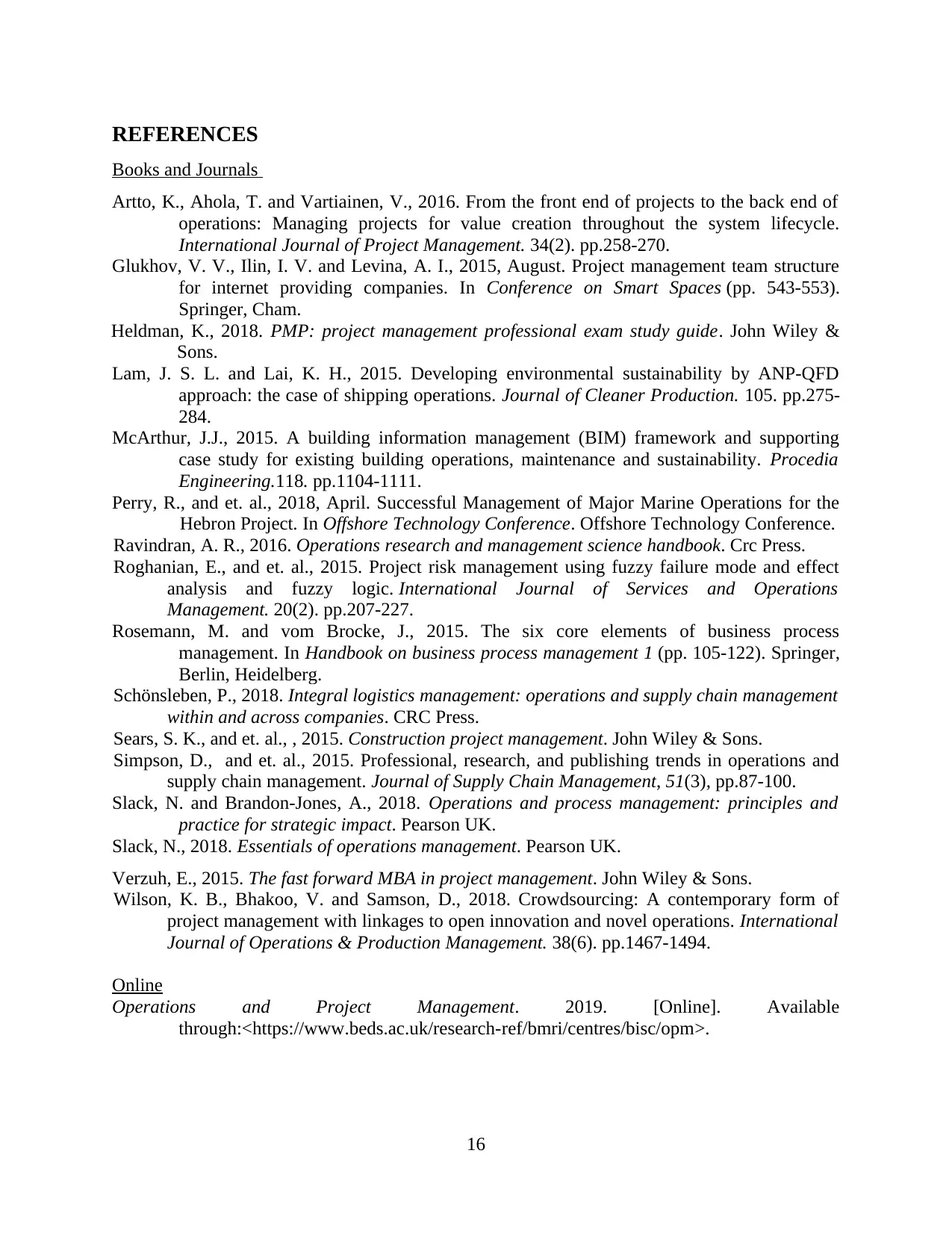
REFERENCES
Books and Journals
Artto, K., Ahola, T. and Vartiainen, V., 2016. From the front end of projects to the back end of
operations: Managing projects for value creation throughout the system lifecycle.
International Journal of Project Management. 34(2). pp.258-270.
Glukhov, V. V., Ilin, I. V. and Levina, A. I., 2015, August. Project management team structure
for internet providing companies. In Conference on Smart Spaces (pp. 543-553).
Springer, Cham.
Heldman, K., 2018. PMP: project management professional exam study guide. John Wiley &
Sons.
Lam, J. S. L. and Lai, K. H., 2015. Developing environmental sustainability by ANP-QFD
approach: the case of shipping operations. Journal of Cleaner Production. 105. pp.275-
284.
McArthur, J.J., 2015. A building information management (BIM) framework and supporting
case study for existing building operations, maintenance and sustainability. Procedia
Engineering.118. pp.1104-1111.
Perry, R., and et. al., 2018, April. Successful Management of Major Marine Operations for the
Hebron Project. In Offshore Technology Conference. Offshore Technology Conference.
Ravindran, A. R., 2016. Operations research and management science handbook. Crc Press.
Roghanian, E., and et. al., 2015. Project risk management using fuzzy failure mode and effect
analysis and fuzzy logic. International Journal of Services and Operations
Management. 20(2). pp.207-227.
Rosemann, M. and vom Brocke, J., 2015. The six core elements of business process
management. In Handbook on business process management 1 (pp. 105-122). Springer,
Berlin, Heidelberg.
Schönsleben, P., 2018. Integral logistics management: operations and supply chain management
within and across companies. CRC Press.
Sears, S. K., and et. al., , 2015. Construction project management. John Wiley & Sons.
Simpson, D., and et. al., 2015. Professional, research, and publishing trends in operations and
supply chain management. Journal of Supply Chain Management, 51(3), pp.87-100.
Slack, N. and Brandon-Jones, A., 2018. Operations and process management: principles and
practice for strategic impact. Pearson UK.
Slack, N., 2018. Essentials of operations management. Pearson UK.
Verzuh, E., 2015. The fast forward MBA in project management. John Wiley & Sons.
Wilson, K. B., Bhakoo, V. and Samson, D., 2018. Crowdsourcing: A contemporary form of
project management with linkages to open innovation and novel operations. International
Journal of Operations & Production Management. 38(6). pp.1467-1494.
Online
Operations and Project Management. 2019. [Online]. Available
through:<https://www.beds.ac.uk/research-ref/bmri/centres/bisc/opm>.
16
Books and Journals
Artto, K., Ahola, T. and Vartiainen, V., 2016. From the front end of projects to the back end of
operations: Managing projects for value creation throughout the system lifecycle.
International Journal of Project Management. 34(2). pp.258-270.
Glukhov, V. V., Ilin, I. V. and Levina, A. I., 2015, August. Project management team structure
for internet providing companies. In Conference on Smart Spaces (pp. 543-553).
Springer, Cham.
Heldman, K., 2018. PMP: project management professional exam study guide. John Wiley &
Sons.
Lam, J. S. L. and Lai, K. H., 2015. Developing environmental sustainability by ANP-QFD
approach: the case of shipping operations. Journal of Cleaner Production. 105. pp.275-
284.
McArthur, J.J., 2015. A building information management (BIM) framework and supporting
case study for existing building operations, maintenance and sustainability. Procedia
Engineering.118. pp.1104-1111.
Perry, R., and et. al., 2018, April. Successful Management of Major Marine Operations for the
Hebron Project. In Offshore Technology Conference. Offshore Technology Conference.
Ravindran, A. R., 2016. Operations research and management science handbook. Crc Press.
Roghanian, E., and et. al., 2015. Project risk management using fuzzy failure mode and effect
analysis and fuzzy logic. International Journal of Services and Operations
Management. 20(2). pp.207-227.
Rosemann, M. and vom Brocke, J., 2015. The six core elements of business process
management. In Handbook on business process management 1 (pp. 105-122). Springer,
Berlin, Heidelberg.
Schönsleben, P., 2018. Integral logistics management: operations and supply chain management
within and across companies. CRC Press.
Sears, S. K., and et. al., , 2015. Construction project management. John Wiley & Sons.
Simpson, D., and et. al., 2015. Professional, research, and publishing trends in operations and
supply chain management. Journal of Supply Chain Management, 51(3), pp.87-100.
Slack, N. and Brandon-Jones, A., 2018. Operations and process management: principles and
practice for strategic impact. Pearson UK.
Slack, N., 2018. Essentials of operations management. Pearson UK.
Verzuh, E., 2015. The fast forward MBA in project management. John Wiley & Sons.
Wilson, K. B., Bhakoo, V. and Samson, D., 2018. Crowdsourcing: A contemporary form of
project management with linkages to open innovation and novel operations. International
Journal of Operations & Production Management. 38(6). pp.1467-1494.
Online
Operations and Project Management. 2019. [Online]. Available
through:<https://www.beds.ac.uk/research-ref/bmri/centres/bisc/opm>.
16
1 out of 18
![[object Object]](/_next/static/media/star-bottom.7253800d.svg)




